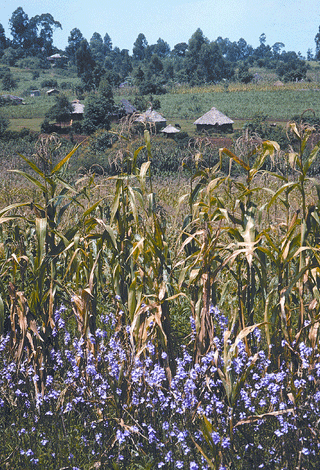
|
Published: 26 March 2012
Unlocking seed dormancy: related genes may be the key
Scientists researching dormancy-breaking mechanisms in the parasitic witchweed plant and fire-adapted plants have found related genes that may be responsible for unlocking the ‘control box’ of seed dormancy.

|
| Witchweed parasitising a maize crop in sub saharan Africa |
The parastic witchweed plant lives off a range of weedy grasses and cereal crops. Its seeds lie in wait in the soil until the host plant starts to grow. Chemical signals called strigolactones (‘witch’ chemicals) produced by the host inadvertently kick-start the witchweed seeds into life, and they then attack the host. The consequences are devastating. In Africa and Asia, witchweeds cause serious losses to food production.
Bushfires are the dormancy-breaking trigger for a different set of plants, adapted to fire. Seeds from these plants lie in wait in the soil until a bushfire passes overhead. The following rains send chemical signals called karrikins (‘smoke' substances) into the soil that tell these seeds to germinate. The plants can then exploit the the new sunny and nutritious environment above. Karrikins play a vital role in landscape regeneration after fire.
The new research, led by Dr Mark Waters of the University of Western Australia and published in the journal Development , has discovered two related genes that distinguish the two signals.
Strigolactones and karrikins comprise a close-knit family of related chemical agents working undercover to trigger the same molecular machinery to stimulate seed germination. However, karrikins do not stimulate witchweeds and strigolactones do not stimulate smoke-responsive species.
‘It's like having two keys to open two different doors of the same control box. Each key has to match the correct lock but both get access to the controls,’ says Dr Waters.
‘It appears that plants have adapted a common mechanism for two very different cases of opportunism – parasitism and fire.’
The research will underpin research into new strategies to promote seed germination, whether for forest rehabilitation, conservation, crop production or eradication of weeds.
Source: University of Western Australia



